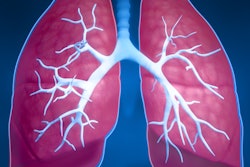Pulmonary embolism can be missed on CT pulmonary angiography (CTPA) exams for many reasons, but computer-aided detection (CAD) software may be able to help prevent these damaging false negatives, according to research in the January issue of the American Journal of Roentgenology.
In a retrospective review, researchers from the University of Maryland School of Medicine found that prototype CAD software for pulmonary embolism (PE-CAD) could detect at least one embolism in more than three of four cases with a missed PE during interpretation. The software also found at least one PE in all missed cases with at least one PE.
"Our study shows the potential value of PE-CAD in a highly relevant group of patients, those with overlooked PE at the time of initial clinical assessment, a cohort that has not been investigated previously," wrote a team led by Dr. Seth Kligerman.
Missed PE
Over the course of a few years, Kligerman noticed that pulmonary emboli were being missed on CTPA. He decided to investigate this issue further after not discovering any data on the prevalence of these false negatives, he told AuntMinnie.com.
"PE being missed on CTPA is not uncommon, especially in cases with subtle isolated emboli or in suboptimal studies degraded by poor PA enhancement, image noise, or respiratory motion," he said.
The researchers were also curious about the imaging outcomes of patients with missed PEs who had follow-up imaging. Kligerman and colleagues retrospectively reviewed more than 6,000 studies performed over a three-year period to collect a cohort of 53 studies with missed PE on CTPA. They then sought to assess the effectiveness of the PE-CAD prototype for detecting these missed emboli (AJR, January 2014, Vol. 202:1, pp. 65-73).
Turning misses into catches
The PE-CAD software, which was developed by Philips Healthcare, was able to identify at least one PE in 41 (77.4%) of 53 cases with a missed PE. PE-CAD identified all 23 cases (100%) with multiple PEs and 18 (60%) of 30 cases with a solitary PE.
CAD yielded significantly higher per-patient sensitivity when the most proximal PE was in a segmental vessel (22/24, 91.7%) than when it was in a subsegmental vessel (19/29, 65.5%). The difference was statistically significant (p = 0.02).
Kligerman noted that false-positive marks remain an issue with PE-CAD; the software produced an average of 3.8 false-positive marks per case (range, 0-23 marks) during the study.
"Most [false-positive] marks are easily dismissed due to incorrect marking of a pulmonary vein, although it is possible that [false-positive] marks can lead to negative studies being incorrectly interpreted as positive," he said.
Important findings
In other notable results, the researchers found that of the 26 missed cases who received imaging follow-up via enhanced chest CT studies performed at a later date, 14 had developed new pulmonary emboli. Of the 12 patients with isolated subsegmental PEs, nine had developed new PE on follow-up scanning, Kligerman said. These new PEs included the development of larger segmental PE in four patients and the development of a large saddle embolus in one patient.
"This suggests that even isolated subsegmental PE, which are often dismissed as insignificant, may be the harbinger of further embolic events," he said. "This finding is very surprising and is important."
While the PE-CAD software is a prototype and has not yet received U.S. Food and Drug Administration (FDA) 510(k) clearance, "it is an amazing piece of technology and I wish I could use it in my clinical practice," Kligerman said.
"If it were available, I would use it [as a second reader] on all CTPA studies initially interpreted as negative by the radiologist," he said. "The time it takes for the software to analyze the study is minimal (average time of 37.5 seconds). However, users must be aware of the software's limitations (i.e., false-positive marks)."
Kligerman said the researchers have many future plans for the software and this dataset of missed PEs, including an investigation into the factors associated with the emboli being missed in the first place. Furthermore, they have gathered a cohort of patients in whom PE was missed on non-PE studies such as CT angiography of the aorta and routine chest CT.
"It turns out that PE-CAD does just as well, if not better, on these cases," Kligerman said. "We are also interested in performing a reader study to determine if PE-CAD would improve the accuracy of the radiologist in these missed cases."





















